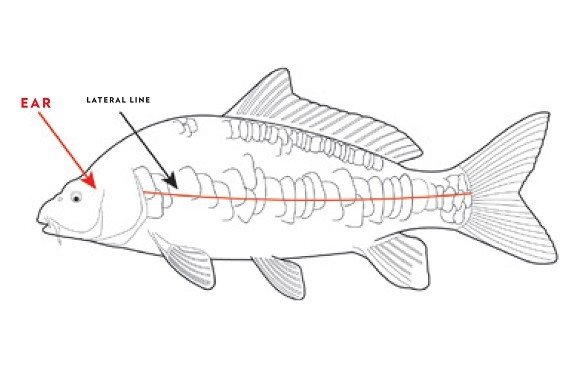
How do carp hear?
Learning the actual mechanics of how a carp lives and breathes - hearing.
Carp are able to sense the movement of sound waves with a variety of apparatus depending on the frequency of the wave. Frequency of sound waves is measured in cycles per second or hertz. Sounds with a high frequency are what we regard as high pitched and sounds with low frequency are regarded as low pitched.
“In carp, high frequency sounds are detected by internal ears with no external opening,” reveals James Anderson, a lecturer at Otley College in Suffolk. “Water is a very good conductor of sound and as the sound wave hits the carp, it travels through the carp’s head reaching its ears which are located in the cranium. Fish ears consist of three semi-circular canals that help with balance. These canals are filled with fluid with one detecting side-to-side movement, one detects up and down and the final canal detects roll.
“The part of the ear that actually detects sound is the otoliths which are small pieces of bone and sit in pockets within the ear. The sound wave travels through the fish’s head at a similar rate to that of the water until it hits the hard structure of the otoliths. The otolith bone then begins to vibrate and stimulate surrounding hair cells which is then fed back through the nervous system.”
The lateral line
“Carp have another sensory organ that detects lower frequency sounds and pressure waves called the lateral line. The lateral line consists of a series of pores called neuromasts along the side of the fish. In some predatory species this lateral line can be extended around the head to help locate prey. They feedback information about the location of other fish and carp use the lateral line to avoid predation. As the sound wave hits the side of the fish, the small hairs in the pores of the lateral line vibrate in a fluid canal. This movement can trigger a reflex action when a fish is under attack and causes an escape response ensuring the fish avoids danger.”
The swim bladder
“Fish are also able to sense sound waves with the aid of their swim bladder, a hollow gas-filled organ that gives the fish buoyancy. The swim bladder helps with hearing by acting as a resonator connected to the fish’s ear. In several species, including carp, the connection is made through a chain of bones that give the fish very good hearing. The swim bladder amplifies any sounds and transmits them to the skull where they are detected by the inner ear.”
Watch the noise levels
“This all means carp are very good at detecting sounds, both from aquatic and terrestrial sources such as people walking along the bank or leads landing in the water. When angling, it is important to keep noise levels to a minimum in order to prevent spooking any fish from the area. When unloading your gear, place tackle items on the floor carefully and walk lightly on gravel paths – and generally just don’t make any sounds that may put the fish on edge.”


